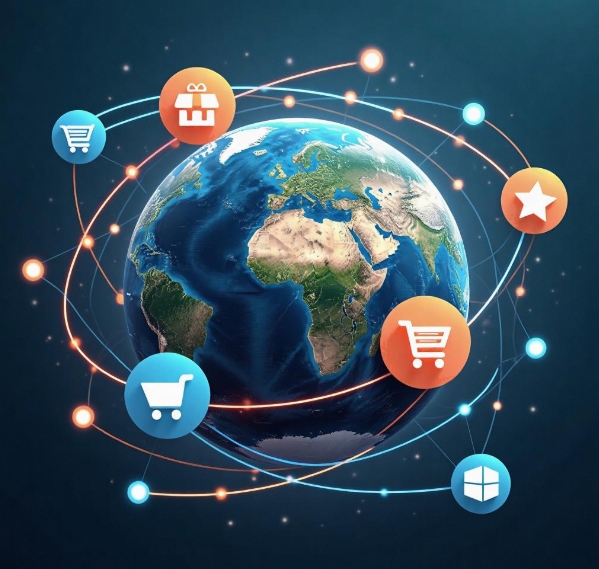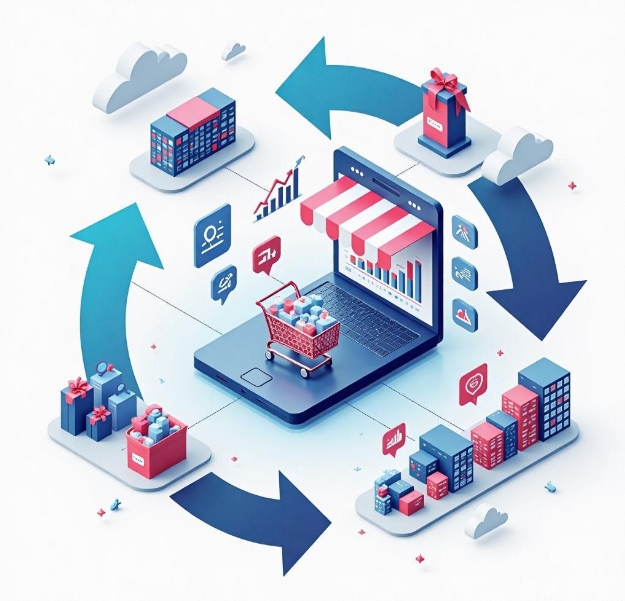Successful Case of a Cross-border Enterprise Distribution Mall Development in Shenzhen
- latest articles
- 1.DApp Development & Customization: Merging Diverse Market Needs with User Experience 2.Analysis of the Core Technical System in DApp Project Development 3.How to achieve cross-chain interoperability in Web3 projects? 4.How does the tokenization of points reconstruct the e-commerce ecosystem? 5.How to Set and Track Data Metrics for a Points Mall? 6.What is DApp Development? Core Concepts and Technical Analysis 7.Inventory of commonly used Web3 development tools and usage tips 8.Development of a Distribution System Integrated with Social E-commerce 9.Six Key Steps for Businesses to Build a Points Mall System 10.What is DApp Development? A Comprehensive Guide from Concept to Implementation
- Popular Articles
- 1.Future Trends and Technology Predictions for APP Development in 2025 2.Analysis of the DeFi Ecosystem: How Developers Can Participate in Decentralized Finance Innovation 3.From Zero to One: How PI Mall Revolutionizes the Traditional E-commerce Model 4.DAPP Development | Best Practices for Professional Customization and Rapid Launch 5.Recommended by the Web3 developer community: the most noteworthy forums and resources 6.From Cloud Computing to Computing Power Leasing: Building a Flexible and Scalable Computing Resource Platform 7.How to Develop a Successful Douyin Mini Program: Technical Architecture and Best Practices 8.Shared Bike System APP: The Convenient Choice in the Era of Smart Travel 9.How to Create a Successful Dating App: From Needs Analysis to User Experience Design 10.From Design to Development: The Complete Process of Bringing an APP Idea to Life
With the rapid development of the global e-commerce industry, cross-border e-commerce has gradually become an important way for many enterprises to expand into international markets. Shenzhen, as China's hub of technology and innovation, has become a gathering place for numerous cross-border e-commerce enterprises, leveraging its favorable market environment and strong technical support. In Shenzhen, a typical cross-border enterprise successfully broke away from the traditional single sales model by developing and successfully operating its own distribution mall, opening up a new path for cross-border e-commerce development. This article will analyze in detail the development process of this enterprise's distribution mall and its successful experiences in the market.
I. Background and Trends of Cross-Border E-commerce
Cross-border e-commerce refers to the business model where enterprises or individuals sell goods from one country to another country or region through e-commerce platforms. With the acceleration of globalization and the development of internet technology, cross-border e-commerce has experienced explosive growth in recent years. According to statistics, the global cross-border e-commerce market size exceeded $4 trillion in 2020, and this trend is expected to continue. Especially after the pandemic, online shopping has become the primary consumption method for people, further unleashing the potential and opportunities of the cross-border e-commerce market.
Against this backdrop, cross-border e-commerce enterprises in Shenzhen actively followed the trend of the times, began expanding into international markets through various channels, and gradually embarked on a path of global development. To this end, many enterprises have gradually shifted from the traditional B2C (business-to-consumer) model to the more flexible and adaptable distribution mall model, thereby gaining more competitive advantages in the global market.
II. Overview of a Cross-Border Enterprise in Shenzhen
This enterprise was established in 2015, specializing in the cross-border sales of smart hardware and consumer electronics. Leveraging the strong supply chain resources and innovative technical support in the Shenzhen region, the enterprise developed rapidly and secured a place in the markets of multiple countries and regions. Due to the high cost-effectiveness and strong technical advantages of its products, the enterprise gradually earned a reputation among customers in the international market.
However, as market competition intensified, the pure B2C e-commerce model could no longer meet the enterprise's needs for further expansion. The management realized that to maintain an advantage in the fierce market competition, more flexible market expansion was necessary. Therefore, developing a distribution mall that met the enterprise's needs became an important way to enhance sales channels and strengthen brand influence.
III. Demand Analysis and Functional Planning of the Distribution Mall
Market Demand Analysis
As cross-border e-commerce matures, enterprises' sales channels are gradually diversifying from single e-commerce platforms. The traditional B2C model sells goods directly to consumers, while the distribution mall provides an intermediary platform for businesses to sell goods to downstream distributors, who then sell to end consumers. The biggest advantage of this model is that it can significantly reduce operational costs for enterprises while expanding the sales network and rapidly increasing market penetration.
This enterprise aims to expand into broader overseas markets, especially emerging markets, by developing a distribution mall. By collaborating with local distributors, the enterprise can enter local markets more efficiently while reducing costs related to logistics, channels, and after-sales services.
Functional Planning
After clarifying market demands, the enterprise began planning the core functions of the distribution mall. The distribution mall must not only meet basic product sales functions but also include a series of features supporting distributor management, order processing, and logistics tracking. Specifically, the functional planning of the distribution mall includes the following aspects:
User Management and Distributor Onboarding: The mall needs to support distributor registration and onboarding management, including distributor review, tier management, and commission settlement.
Product Management and Sales: Functions such as product information display, price management, and inventory management must be simple and easy to use, ensuring distributors can quickly access the latest product information and conduct sales.
Order Management and Logistics Tracking: The mall needs to effectively manage orders and provide real-time logistics tracking information, ensuring distributors can promptly obtain order status and product shipping details.
Commission Settlement and Financial Management: The distribution mall also needs to establish a clear commission settlement system to ensure distributors receive their commissions on time according to the agreed ratios, avoiding any negative impact on distributor motivation due to settlement issues.
Multi-language and Multi-currency Support: To cater to global market demands, the mall must support multiple languages and currencies, making it convenient for distributors from different regions to use.
Data Analysis and Reporting: The distribution mall needs to provide data analysis functions, helping the enterprise monitor sales in real-time, analyze sales trends in various regions, and evaluate distributor performance to make more precise market decisions.
IV. Mall Development Process
Technology Selection and Platform Architecture
The first step in mall development was technology selection. Considering the enterprise's cross-border e-commerce business covers multiple countries and regions, the mall needs to have high scalability and stability. The enterprise decided to adopt a microservices architecture to support future business expansion. At the same time, a mainstream cloud computing platform was chosen for deployment to ensure high availability and performance of the system.
During the development process, the team focused on the mall's operability and user experience, especially in areas such as user registration, product browsing, and order processing. To ensure efficient operation of the mall, the system adopted a multi-layer caching mechanism and combined it with a distributed database for data storage and management.
UI/UX Design and User Experience
The user experience design of the mall is crucial. The enterprise collaborated with a professional UI/UX design company to optimize the operational processes for distributors, ensuring the mall interface is simple and easy to understand, with smooth operations. The mall's homepage design showcases best-selling product lists, distributor rankings, and the latest promotional activities, enhancing the mall's appeal. Additionally, the mall optimized the mobile experience, ensuring distributors can easily complete operations from anywhere.
System Integration and Testing
During the development process, the enterprise team integrated the distribution mall with existing systems such as inventory management and order management to ensure real-time data synchronization and accuracy. To guarantee system stability and security, the development team conducted multiple rounds of stress testing, security testing, and functional testing, ensuring the mall runs smoothly after launch.
V. Promotion and Operation of the Distribution Mall
After the mall development was completed, the enterprise actively promoted the distribution mall to attract more distributors. The enterprise conducted marketing through various methods, including but not limited to:
Social Media Advertising: Advertising on social platforms like Facebook and Instagram to attract the attention of overseas distributors.
Online Promotional Activities: Regularly holding promotional events to attract distributors and incentivize them to increase sales.
Global Logistics Services: The enterprise also partnered with several globally renowned logistics companies to ensure goods are quickly delivered to overseas distributors and end consumers.
Partnerships: Establishing cooperative relationships with local e-commerce platforms, chambers of commerce, and other institutions to expand brand influence and attract more distributors.
Through a series of marketing and operational efforts, the enterprise successfully attracted a large number of overseas distributors to join the mall, forming a stable distribution network.
VI. Success Experiences and Challenges
Success Experiences
The enterprise accumulated rich experience during the development and operation of the distribution mall, with the following points being particularly important:
Accurate Market Positioning: By analyzing market demands in different countries and regions, the enterprise tailored its promotion strategies for the distribution mall.
Comprehensive Distributor Support: The enterprise provided distributors with abundant training resources and technical support, helping them better understand products and improve sales capabilities.
Flexible Settlement System: A transparent and fair commission settlement system greatly enhanced distributor motivation and ensured long-term cooperative relationships.
Challenges Faced
Despite achieving significant results, the enterprise also faced some challenges during the operation of the distribution mall, such as high cross-border logistics costs, inconvenient payment methods in some regions, and compliance issues with laws and regulations. To address these, the enterprise continuously optimized logistics solutions, introduced multiple payment methods, and strengthened cooperation with local legal advisors, gradually overcoming these problems.
VII. Conclusion
By developing and successfully operating a distribution mall, a cross-border enterprise in Shenzhen broke away from the traditional sales model and established a flexible, diversified global sales channel. This successful case not only provides valuable experience for cross-border e-commerce enterprises but also offers better and more efficient services for distributors and consumers in the global market. In the future, as the cross-border e-commerce industry continues to develop and innovate, similar distribution mall models will be promoted and applied in more fields.
-

How does the tokenization of points reconstruct the e-commerce ecosystem?
With the continuous advancement of internet technology and the gradual prolifera···
-

How to Set and Track Data Metrics for a Points Mall?
With the rapid development of the e-commerce industry, points malls, as a common···
-

Development of a Distribution System Integrated with Social E-commerce
With the rapid development of internet technology, the e-commerce industry has e···

 Blockchain
Blockchain












